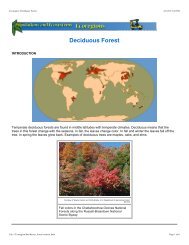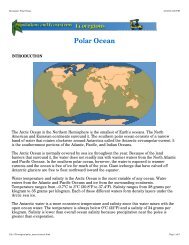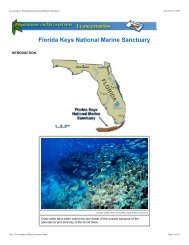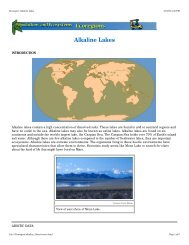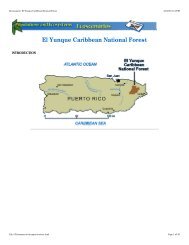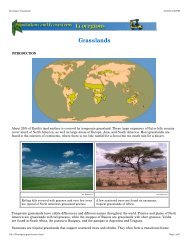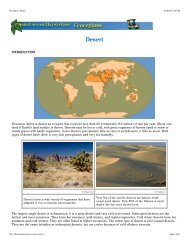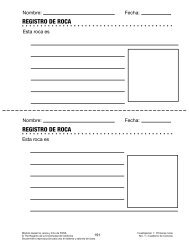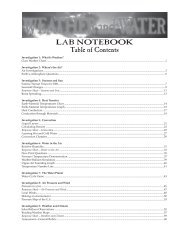Ecoscenarios Combined - FOSSweb
Ecoscenarios Combined - FOSSweb
Ecoscenarios Combined - FOSSweb
You also want an ePaper? Increase the reach of your titles
YUMPU automatically turns print PDFs into web optimized ePapers that Google loves.
Ecoscenario: Cimarron National Grasslands<br />
4/16/03 3:09 PM<br />
As settlers began moving west, the grassland was converted to grazing lands for cattle. Over 100 years ago, the<br />
land of Cimarron National Grassland was a cattle ranch known as Point of Rocks Ranch, operated by the Beaty<br />
brothers. This was the first permanent settlement in the area. Around 1885, homesteaders began to settle in this<br />
area as well. The rolling grassland was turned into a sea of wheat and other grains.<br />
Years of cattle grazing and farming, followed by a drought, degraded the soils and made them unproductive. By the<br />
1930s many acres were barren. The strong winds that blow across the prairie swept up the loose soil, creating huge<br />
dust and sand storms. This area was part of the Dust Bowl, an area that covered parts of Kansas, Oklahoma, and<br />
Texas, named for the great dust storms. Morton County, where part of Cimarron National Grassland is, was one of<br />
the most devastated areas.<br />
Courtesy of U.S. Department of Agriculture, Forest Service<br />
Green area northwest of Elkhart, Kansas, is land in the Cimarron<br />
National Grassland.<br />
The U.S. government wanted to stabilize the soil so the land could be used again for agriculture. Healthy<br />
grasslands reduce soil erosion and water runoff and provide a dependable supply of summer forage for livestock and<br />
wildlife. The U.S. Congress approved the Bankhead-Jones Farm Tenant Act in 1937, allowing the government to buy<br />
some of this unproductive land with loose soil. The land was first administered by the U.S. Soil Conservation<br />
Service and in 1954 was turned over to the U.S. Department of Agriculture Forest Service. The former Point of<br />
Rocks Ranch became Cimarron National Grassland in 1960. It is the largest tract of public land in Kansas.<br />
Cimarron National Grassland is now a mixed-grass and shortgrass prairie. Riparian plant communities occur along<br />
the Cimarron River. Pronghorn antelope, bison, white-tailed deer, and cattle graze the land. This section of Kansas<br />
is at the heart of a major bird migration route. The surrounding land is primiarly agricultural, so Cimarron National<br />
Grassland serves as an important wintering island for birds.<br />
ABIOTIC DATA<br />
The climate of Cimarron National Grassland is semiarid, with warm summers and cold, dry winters. Winds blow<br />
across the grasslands, which makes the soil even drier. The growing and grazing season in this ecosystem is<br />
between April and September.<br />
file:///Ecoscenario/cimarron/content.html<br />
Page 2 of 12



